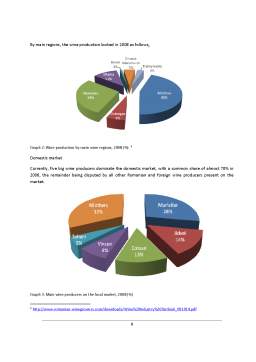Cuprins
- Introduction 3
- 1. Market capacity 4
- 2. Market evolution 7
- 3. Market structure 12
- 4. Product supply 14
- 5. Exports and Imports 19
- 6. Prices and tariffs. 24
- 8. Reference list 27
Extras din proiect
Introduction
The fact that Romanians like to drink wine is well known by Europeans. But they miss one aspect: Romanians, above all, are real wine growers. This is due to the geography that we live in. Of course, the geography would be worthless if we didn’t take in account the talent of our viticulturists.
There are several capital differences between the people living in different areas of the country, each with advantages and disadvantages. Same thing could be said about the wines coming from these certain zone: each wine is special. No wonder why the natives like to drink wine: every person has a favorite Romanian wine, sweet or dry, red or white.
The Romanian viticulture goes back at least 4000 years ago. There’s a legend that states that Dionysos, the god of wine, was born in Thracia. The wine was introduced by the Greeks, in Dacia, who arrived from the Black Sea. In the middle ages, the Saxons brought different types of Germanic grapes and the wine production diversified and developed Later, in the 1880, Phylloxera appeared in Romania, coming from North America. This insect devastated the Romanian wine cultures, along with other European cultures. This unfortunate event had a strong impact on the local viticulture, but eventually, different sorts of wines were imported from France. The Romanian wine culture was back on tracks!
The general climate is continental with very hot summers and cold winters, alleviated slightly by the influence of the Black Sea, particularly in the extreme south-east. In Transylvania, west and north of the Carpathian Mountains, the altitude gives slightly cooler summers than are found elsewhere in the country. The soils are varied; they are basically stony and well-drained around the Carpathians, but more alluvial and sandy in the coastal area.
Therefore, the viticulture is done on hills and well-drained slopes, having the best sun exposure. Other areas preferred by the wine growers are the valleys that are protected against the cold winter winds and late spring frosts.
Wines of Romania
Romania numbers among the few countries in the world that benefits of such favorable conditions for vine growing and wine making, excepting perhaps only France, which can produce such a great variety of wines. From the divine white wines of Jidvei and Cotnari to the red wines of Murfatlar in Dobrogea, Romania has always offered some of the most exciting and interesting wines in the world.
Romania - a wine country
Romania is a major European wine country with rich historic and cultural traditions, many of them directly related to this marvelous drink, rightfully considered divine liquor. Today the country builds its own future in consonance with that of the European Union and in this sense undergoes profound changes, while aspiring to become a valued member of the world wine community as a producer of highly praised quality wines.
Romania is the 5th wine producer in Europe.
Place of Romania world-wide:
- area under vine (6th position in the EU)
- grape production (7th position in the EU)
- wine production (7th position in the EU)
- among the first 10 countries in the world with regard to area under vine and wine production.
1. Market capacity
Wine market posted a total turnover of 350 million euros in 2008, while consumption is 26.6 liters per capita is expected to grow in 2009 to 30 liters per capita.
1.1 The number of potential consumers ( potential market )
The potential consumers of wine market, represents the entire Romanian national population, who turned 18 years, plus other nationalities who, by their religion and tradition, they are allowed to drink alcohol. Most people, 18 million, according to 2002 census, are not prohibited the consumption of alcoholic beverages.
Preview document
Conținut arhivă zip
- Market Analysis for Wines on the Romanian Market.docx




























